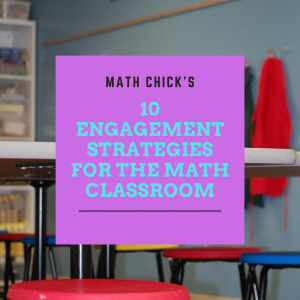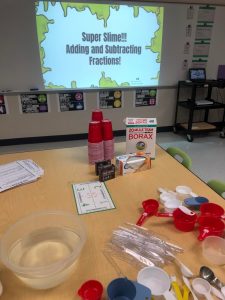
Engagement strategies are research based and a proven way for students to obtain new knowledge. These strategies are so powerful and allow students to put new knowledge into long term memory! Engagement strategies are for every subject and can be done in every classroom, even in math class! Let’s dive right in and see 10 easy ways you can set the stage to engage in your math classroom!
Know your students likes and interests!
 You know that trends come and go, so sometimes it is hard to know what is relevant in a student’s life. For example, a couple of years ago I created an entire activity around Pokemon Go. Do you remember when that was the latest craze? The kids were so excited to analyze data about their favorite game, but over time the happiness faded. Now my students are obsessed with Fortnite. I am sure you have seen the dances and heard the conversations about this addicting game. So I changed the data activity from a Pokemon Go activity to Fortnite activity. The kids absolutely loved it and thought I was the coolest because I knew about Fortnite! If you are not sure what your students like, ask them! Give them a survey or have a conversation with the students to find out what is relevant to them. Students will appreciate that their teacher cares enough to ask and their engagement in your lesson will skyrocket!
You know that trends come and go, so sometimes it is hard to know what is relevant in a student’s life. For example, a couple of years ago I created an entire activity around Pokemon Go. Do you remember when that was the latest craze? The kids were so excited to analyze data about their favorite game, but over time the happiness faded. Now my students are obsessed with Fortnite. I am sure you have seen the dances and heard the conversations about this addicting game. So I changed the data activity from a Pokemon Go activity to Fortnite activity. The kids absolutely loved it and thought I was the coolest because I knew about Fortnite! If you are not sure what your students like, ask them! Give them a survey or have a conversation with the students to find out what is relevant to them. Students will appreciate that their teacher cares enough to ask and their engagement in your lesson will skyrocket!
Get up and Move!
You would be surprised at how engaging it is for students to get up out of their seat and move! I love musical chairs! You can use a simple worksheet and then every few minutes, play some music and move around.
When the music stops, the students find their new partner and complete the next set of problems. This strategy turns a boring worksheet into a fun and engaging activity. A scavenger hunt is another great way to get kids up out of their seat and moving. I love to use scavenger hunts because they are a loop and students will have to complete the loop correctly in order to finish the scavenger hunt. The loop serves as a self checking activity.
Set the Stage to Engage with a Simple Room Transformation
Room transformations are all the rage in education today but can be very overwhelming to a teacher who has limited money or time. I know because I am one of those teachers! I am here to tell you a little can go along way! Just wearing a shirt or a costume can reel your kids in and get them excited about a new topic! When I first started room transformations, I really called them mini-room transformations because of the scale backed version of my room transformation. It made me feel better to start out small. This was less intimidating to me. One thing I did was reach out to my school staff. During my first transformation, I emailed and asked if anyone has any Hawaiian decorations or clothes. I received a ton of stuff from all over my school! So all I did was buy Hawaiian leis on Amazon for super cheap and I had instant engagement for my students!
For my “Deep Dive” room transformation, I asked my staff for black lights and received a few to borrow for the day. I made fish on neon paper, which I pasted around the room and gave my kids highlighters to write with and you would have thought my classroom had transformed into a magical place!
Integrate Technology!
We all know that technology is a huge engagement factor with our students! We live in a very tech advanced world. Students love to use technology in math class. You can incorporate robots into your math class. Ozobots are an awesome tool and students love how easy they are to use and code. Spheros are another fun robot to incorporate. You can go as simple as QR codes (which does integrate technology) or go more complex with a digital escape room! I don’t use the same tech over and over again. I make sure to change it up here and there to pique the students’ interest.
Summative Projects or Big Finales!
I love to incorporate big projects at the end of a unit! These particular activities always make me so tired but it is a good tired. I have taken a recipe for slime and turned it into an adding and subtracting fractions project! If the students correctly solve the problems, they will see the recipe for the slime.
I have also made play dough using the same type of activity. Students had to solve all types of fraction operation problems in order to earn the materials to make their own play dough. The kids had a blast and worked so hard to solve those math problems.
Games are always a great Engagement Strategy
Games are such an old school way to engage students, but have you thought about games other than a simple partner game, card game or board game? For example, I had my students play a game to become a Math Jedi. Students had partners and were assigned a character from the Star Wars movies. Students completed the problems and moved their character along the way. I could not believe how hard the students worked in order to simply move their character along the way. That was literally it! They were so engaged and solved super rigorous problems in order to move a piece of paper on the board. How simple is that engagement?? Another time, students pretended to be construction workers to create quadrilaterals with certain areas and perimeter. Students were paid “construction” bucks for a job well done. These students worked so hard for fake money!! How cool is that?
Plan a Trip!
I tried really hard this year to plan a field trip about math. This is super hard to do but I am happy to say that this year we are taking a trip to the zoo to learn about math! I know what you are thinking, how could a trip to the zoo be about math? Well, I reached out to our zoo and I asked the person in charge of field trips if they could specifically talk to our students about how math affects the everyday work at the zoo. I asked the zoo to speak about proper enclosures, proper amounts of food, and how the zoo budgets their money. To my surprise the zoo was happily ready to talk to my kids about math at the zoo! After the zoo, we will complete our own math project about animal enclosures with an appropriate enclosure area and perimeter.
Parent Involvement
Get your students’ parents involved! I have invited parents to come and volunteer to help me out during a game or big summative project. During my play dough project, I had a parent volunteer to help me and it was awesome! I have also sent students home to interview their parents on financial literacy topics. It is important to send emails out asking for supplies and/or donate supplies. I have had parents happily donate supplies for big projects! If the parents are engaged and excited, the students will be too.
Change of Scenery
Sometimes all you need is to change the scenery. Hold class outside one pretty afternoon. Have class in the main hallway. You would be surprised how engaged students are by taking them outside. I have held math class outside a few times. Sometimes we just work in partners on a beautiful day. Other times we have played bowling or kickball! Multiplication fact kickball is so fun!
Stem Integration
This is one of my favorite engagement strategies! I think some teachers are super overwhelmed when you mention STEM but I am here to tell you that it doesn’t have to be overwhelming! STEM is not complex or crazy hard to create. STEM can be as simple as creating a paper circuit to light up a coordinate grid. STEM can also be as simple as building paper cup towers while learning about scatterplot graphs. Sure you can buy huge STEM kits that are super complex to integrate into your math classroom but STEM can also be short, sweet and cheap!
What Will You Do to Engage Your Students?
These are just a few of the ways that I engage my students in my math class. I don’t do all of these in one day or even one week. I try to do one of these at least once or twice a week! Your job as a teacher is to become comfortable with one of these strategies and then add on another one once you are feeling comfortable. A teacher who is overwhelmed or not comfortable will not produce the same engagement as a teacher who is comfortable in their own shoes using their choice of familiar engagement strategies. So make sure you are comfortable! Baby steps are the key to trying new things. I did not try all of these at once, this is 17 years in the making! I would love to hear what you decide to try in your classroom! Make sure to tag me in your favorite social media platform!






 Thank you for stopping by today! I hope you were inspired and you were able to find something new to try in your own classroom! If you didn’t find what you were looking for- please email me! I am happy to help!
Thank you for stopping by today! I hope you were inspired and you were able to find something new to try in your own classroom! If you didn’t find what you were looking for- please email me! I am happy to help!